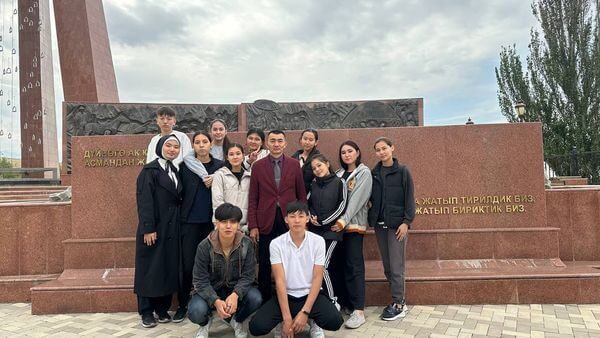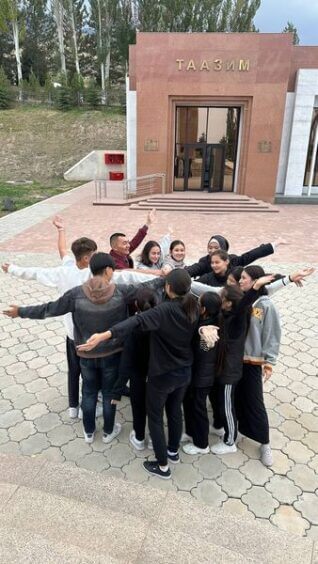On October 6, 2023 students of the 18th group of the Faculty of Medicine of KSMA named after I.K. Akhunbaev under the guidance of the curator, Candidate of Biological Sciences, Acting Assistant Professor of the Department of Medical Biology, Genetics and Parasitology Raimkulov Kursanbekalov,
acting assistant professor of the Department of Medical Biology, Genetics and Parasitology Raimkulov Kursanbek Mamasalievich, made an expedition to the memorial complex "Ata-Beyit".

Let us not forget the history of our ancestors!
ABOUT ATA-BEYIT
The memorial complex "Ata-Beyit" is the burial place of the victims of political repressions of 1938 (84 years ago). It is located 30 kilometers south of Bishkek, near the village of Chon-Tash on the mountainside.
Stories about people who suffered from repressions are closely connected with the creation of the modern Kyrgyz state. As part of the Russian Empire (1876-1917), the land of the Kyrgyz was divided into small provinces within the Turkestan Province. In 1918-1924, at the beginning of the Soviet era, the same region was the Turkestan ASSR. J. Abramov, E. Arabaev, A. Sydykov and others in 1922 (100 years ago), as representatives of intellectuals tried to create the Mountain-Kyrgyz region, but failed. In 1924, the current map was drawn up and the Kara-Kyrgyz Autonomous Region was formed, with Imanaly Aidarbekov as its chairman. In 1925 it was transformed into the Kyrgyz Autonomous Region with Abdykadyr Orozbekov as its chairman.In 1926 it became the Kyrgyz ASSR. In 1936, the Kyrgyz SSR was created.
In 1937-38 mass political (Stalinist) repressions took place in the USSR. This is called the "Great Terror" or "Yezhovshchina". A total of 681,692 people went out to be shot. On November 5-8, 1938 in the Kyrgyz SSR 138 people Students of KSMA visited the memorial complex "Ata-Beyit".
On October 6, 2023 students of the 18th group of the Faculty of Medicine of KSMA named after I.K. Akhunbaev under the guidance of the curator, Candidate of Biological Sciences, Acting Assistant Professor of the Department of Medical Biology, Genetics and Parasitology Raimkulov Kursanbekalov,
acting assistant professor of the Department of Medical Biology, Genetics and Parasitology Raimkulov Kursanbek Mamasalievich, made an expedition to the memorial complex "Ata-Beyit".
Let us not forget the history of our ancestors!
ABOUT ATA-BEYIT
The memorial complex "Ata-Beyit" is the burial place of the victims of political repressions of 1938 (84 years ago). It is located 30 kilometers south of Bishkek, near the village of Chon-Tash on the mountainside.
Stories about people who suffered from repressions are closely connected with the creation of the modern Kyrgyz state. As part of the Russian Empire (1876-1917), the land of the Kyrgyz was divided into small provinces within the Turkestan Province. In 1918-1924, at the beginning of the Soviet era, the same region was the Turkestan ASSR. J. Abramov, E. Arabaev, A. Sydykov and others in 1922 (100 years ago), as representatives of intellectuals tried to create the Mountain-Kyrgyz region, but failed. In 1924, the current map was drawn up and the Kara-Kyrgyz Autonomous Region was formed, with Imanaly Aidarbekov as its chairman. In 1925 it was transformed into the Kyrgyz Autonomous Region with Abdykadyr Orozbekov as its chairman.In 1926 it became the Kyrgyz ASSR. In 1936, the Kyrgyz SSR was created.

In 1937-38 mass political (Stalinist) repressions took place in the USSR. This is called the "Great Terror" or "Yezhovshchina". A total of 681,692 people went out to be shot. On November 5-8, 1938 in the Kyrgyz SSR 138 people were shot and buried in an old kiln of a small brick factory in the mountains. Among them were well-known political, state and public figures of Kyrgyzstan - J. Abdrakhmanov, B. Isakeev, T. Aitmatov, H. Jeenbaev, E. Esenamanov, M. Salikhov, S. Shamurzin, I. Aidarbekov, K. Tynystanov and others. There were also representatives of other nationalities among them.
The burial place of 138 people was kept secret for 53 years. Only one worker (Abykan Kydyraliev), who lived not far from this place, knew that people were buried here, but he was afraid of the authorities and could not tell anyone. Only before his death in 1973, he bequeathed this secret to his daughter Bubuira Kydyralieva. In 1991, when our nation gained independence, Bubuira-apa told about this place to Captain Bolot Abdrakhmanov, who worked in the NSC(National Security Committee). After that, in June-July 1991, exhumation works began.
Bubuira-apa was born in 1926. She was the eldest of four children. Her parents worked at the PCIA (Public Commissariat of Internal Affairs) country house and lived there. She was 12 years old at the time of the repressions. In 1941, her father went to war and returned safely. When she was 17, she was kidnapped and married off. Her first child was miscarried and her husband died of illness soon after. After that she adopted Karachai, Russian and Chuvash orphans. An activist, Mother Bubuir in her youth was a deputy in her village and at the age of 24 she combined her studies and work, and at the age of 34 she entered the Leningrad University. After graduation she organized a mobile cinema "Balapan", which was shown around Bishkek. At the age of 37, she married for the second time to a man who had 4 children. After 10 years of living together, her husband said goodbye to this world. At that time (in 1973), Bubuir-apa's father was also close to death, and he bequeathed to his daughter to reveal the secret of the place where the Kyrgyz elite was buried and to tell the people when good times would come. Mother Bubuir fell ill in 1989 and began trying to bring her father's will to the people. After she met Captain Abramov in 1991, excavations began and what he had said was confirmed.
On June 12, 1991, under the direction of archaeologist M. I. Moskalev, exhumation began, and it was completed in July. The indictment was found in the pockets of some corpses. Investigation showed that the accusations were groundless, and the "confessions" were obtained through unbearable torture. A government commission was set up to organize their reburial and memorialization. On August 30, 1991, a mourning rally was held in Bishkek, after which the victims of repression were buried with a mourning aria near the place where they were shot. The place where they were buried at the suggestion of Ch. Aitmatov was named "Ata-Beyit", which means "Father's grave".
On July 14, 2000 the memorial complex "Ata-Beyit" was built and a museum was opened at this historical place. In 2000, Boubuira Kydyralieva was awarded the Medal of Courage. On June 14, 2008, the famous writer Chingiz Aitmatov was also buried here. In 2010, the victims of the April 7 revolution were buried. In 2016, a monument dedicated to the national liberation uprising of 1916 was installed in "Ata Beyit".
The trip was very good and productive. The students listened with interest to the guide in the museum and received detailed information about the events of that time. They visited the museum and saw the pit with their own eyes.
Everyone admired the beauty of nature, and it is safe to say that this day was imprinted in their hearts for a long time. Warm feelings appeared on the students' faces and they plan more such expeditions in the future.
The students expressed their deep gratitude to their supervisor Raimkulov Kursanbek Mamasalievich for such a meaningful and interesting day.